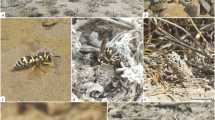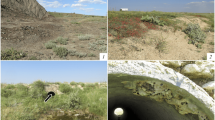Abstract
A comparative analysis of the main parameters of the nest structure and composition in Euodynerus quadrifasciatus, Eu. dantici, Eu. disconotatus, and Eu. velutinus in the Crimea is given. Nests of all the studied species were obtained from trap-nests made of reed stems; the nests of Eu. dantici and Eu. disconotatus were additionally obtained from the abandoned cells of the nests of Sceliphron destillatorium. The nest of Eu. quadrifasciatus consists of a consecutive row of cells, each cell having its own bottom and lid with empty space between them; the nests of three other species consist of an uninterrupted row of cells without spaces, so that the cell bottoms act as partitions. The data on the diameter and length of nest cavities occupied by the studied species, the number of cells in nests, the sex ratio and the length of the cells with prospective females and males are reported. The correlations between the length of the cells and the diameter of the occupied cavities and between the length of the rear empty nest space and vestibule and the length of the occupied nest cavity are analyzed. The structure of cocoons and final nest plugs are described. The difference in the evolution of nest building instincts in members of the subgenera Pareuodynerus and Euodynerus s. str. and the role of adaptation to nest tenantry in the evolution of nest building instincts of Eu. dantici and Eu. disconotatus are discussed.
Similar content being viewed by others
References
Blüthgen, P., “Zur Brutbiologie von Euodynerus (Pareuodynerus) posticus (H.-Sch.) (innumerabilis [Sss.]) (Hym., Vespidae, Eumeninae),” Anz. Schädlingsk. 24(10), 153–154 (1951).
Blüthgen, P., “Die Faltenwespen Mitteleuropas (Hymenoptera, Diploptera),” Abh. Deutsch. Akad. Wiss. Berlin Klas. Chem. Geol. Biol., No. 2, 1–252 (1961).
Buck, M., Marshall, S.A., and Cheung, D.K.B., “Identification Atlas of the Vespidae (Hymenoptera, Aculeata) of the Northeastern Nearctic Region,” Canad. J. Arthropod Ident., No. 5, 1–492 (2008).
Carpenter, J.M., “A Synonymic Generic Checklist of the Eumeninae (Hymenoptera: Vespidae),” Psyche 93(1–2), 61–90 (1986).
Evans, H.E., “Notes on the Biology of Four Species of Ground-Nesting Vespidae,” Proc. Entomol. Soc. Wash. 58(5), 265–270 (1956).
Evans, H.E., “Observations on the Nests and Prey of Eumenid Wasps (Hymenoptera, Eumenidae),” Psyche 84(3–4), 255–259 (1977).
Fateryga, A.V., “The Nest Structure in Four Species of Solitary Wasps of the Subfamily Eumeninae (Hymenoptera, Vespidae),” Zool. Zh. 91(10), 1199–1209 (2012).
Isely, D., “The Biology of Some Kansas Eumenidae,” Univ. Kansas Sci. Bull. 8, 233–309 (1913).
Ivanov, S.P. and Fateryga, A.V., “The Nesting Biology of the Solitary Wasp Syneuodynerus egregius (Hymenoptera: Vespidae: Eumeninae) in the Crimea,” Vestnik Zool. 40(4), 341–349 (2006).
Ivanov, S.P. and Fateryga, A.V., “Parallelisms in the Nesting Instincts in Solitary Bees and Wasps (Hymenoptera: Megachilidae, Megachilinae; Vespidae, Eumeninae),” in Studies on Hymenopterous Insects, Ed. by A.P. Rasnitsyn and V.E. Gokhman (KMK Sci. Press, Moscow, 2007), pp. 205–218 [in Russian].
Ivanov, S.P., Fateryga, A.V., and Zhidkov, V.Yu., “Using Trap-Nests and Fabre Hives to Study the Fauna and Nesting Biology of Solitary Wasps and Bees (Hymenoptera, Aculeata) in Karadag Nature Reserve,” in Karadag—2009, Ed. by A.V. Gaevskaya and A.L. Morozova (EKOSI-Gidrofisika, Sevastopol, 2009), pp. 215–222 [in Russian].
Iwata, K., “Habits of Eight Species of Eumeninae (Rhynchium, Lionotus, and Symmorphus) in Japan,” Mushi 11, 110–132 (1938).
Krombein, K.V., Trap-Nesting Wasps and Bees: Life Histories, Nests, and Associates (Smithsonian Press, Washington, 1967).
Kurzenko, N.V., “Family Vespidae, Vespid Wasps,” in Keys to Insects of the Russian Far East. Vol. 4, Part 1: Neuropteroidea, Mecoptera, and Hymenoptera (Nauka, St. Petersburg, 1995), pp. 295–324 [in Russian].
Lakin, G.F., Biometry (Vysshaya Shkola, Moscow, 1990) [in Russian].
Medler, J.T., “Biology of Rygchium foraminatum in Trap-Nests in Wisconsin,” Ann. Entomol. Soc. Amer. 57(1), 56–60 (1964).
Rau, P., “The Relation of the Size of the Cell to the Sex of the Wasp in Odynerus foraminatus Sauss. (Hymenoptera: Vespidae),” Entomol. News 43(5), 119–121 (1932).
Author information
Authors and Affiliations
Additional information
Original Russian Text © A.V. Fateryga, 2012, published in Entomologicheskoe Obozrenie, 2012, Vol. 91, No. 3, pp. 520–532.
Rights and permissions
About this article
Cite this article
Fateryga, A.V. The nest structure in four wasp species of the genus Euodynerus Dalla Torre (Hymenoptera, Vespidae: Eumeninae). Entmol. Rev. 93, 412–421 (2013). https://doi.org/10.1134/S0013873813030027
Received:
Published:
Issue Date:
DOI: https://doi.org/10.1134/S0013873813030027




